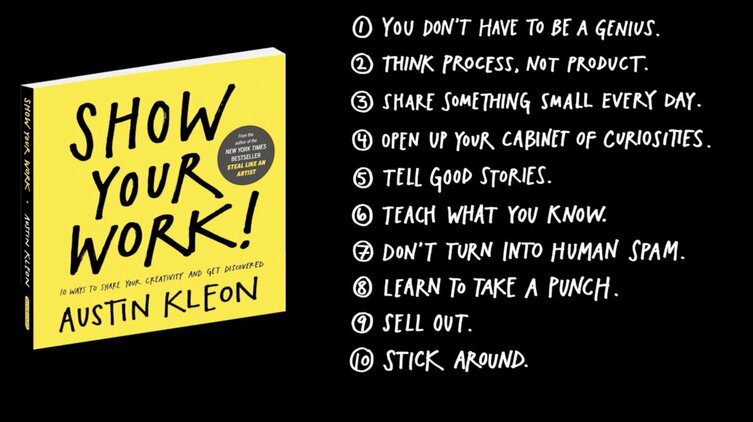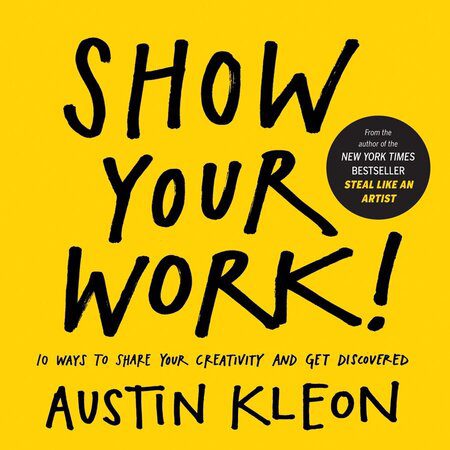In Show Your Work!: 10 Ways to Share Your Creativity and Get Discovered, author Austin Kleon writes about self-promotion, thinking about your work as a never-ending process, how to share your process in a way that attracts people who might be interested in what you do, and how to deal with the ups and downs of putting yourself and your work out in the world.
Show Your Work is a list of 10 ways to share your creativity and get discovered in the process. The big idea of the book is that creativity is about the process and not the product. By sharing your process openly, you can build an audience that you can use to gather feedback, make a personal and professional connection or patronage.
Show Your Work! Book Trailer from Austin Kleon on Vimeo.

“ You don’t really find an audience for your work; they find you. But it’s not enough to be good. In order to be found, you have to be findable.”
- You don’t have to be a genius
Find a Scenius
The Internet is basically a bunch of sceniuses connected together, divorced from physical geography. Blogs, social media sites, email groups, discussion boards, forums—they’re all the same thing: virtual scenes where people go to hang out and talk about the things they care about. There’s no bouncer, no gatekeeper, and no barrier to entering these scenes: You don’t have to be rich, you don’t have to be famous, and you don’t have to have a fancy résumé or a degree from an expensive school. Online, everyone—the artist and the curator, the master and the apprentice, the expert and the amateur—has the ability to contribute something.
Be an Amateur
On the spectrum of creative work, the difference between the mediocre and the good is vast. Mediocrity is, however, still on the spectrum; you can move from mediocre to good in increments. The real gap is between doing nothing and doing something.” Amateurs know that contributing something is better than contributing nothing.
2. Think Process not Product
By putting things out there, consistently, you can form a relationship with your customers. It allows them to see the person behind the products.” Audiences not only want to stumble across great work, but they, too, long to be creative and part of the creative process. By letting go of our egos and sharing our process, we allow for the possibility of people having an ongoing connection with us and our work, which helps us move more of our product.
“In order for connection to happen, we have to allow ourselves to be seen—really seen.”—Brené Brown
3. Share something small every day
Overnight success is a myth. Dig into almost every overnight success story and you’ll find about a decade’s worth of hard work and perseverance. Building a substantial body of work takes a long time—a lifetime, really—but thankfully, you don’t need that time all in one big chunk. So forget about decades, forget about years, and forget about months. Focus on days.
Daily Dispatch
A daily dispatch is even better than a résumé or a portfolio, because it shows what we’re working on right now. A good daily dispatch is like getting all the DVD extras before a movie comes out—you get to watch deleted scenes and listen to director’s commentary while the movie is being made.
The form of what you share doesn’t matter. Your daily dispatch can be anything you want—a blog post, an email, a tweet, a YouTube video, or some other little bit of media. There’s no one-size-fits-all plan for everybody.
“Post as though everyone who can read it has the power to fire you.” -Lauren Cerand
4. Open up your cabinet of curiosities
The problem with hoarding is you end up living off your reserves. Eventually, you’ll become stale. If you give away everything you have, you are left with nothing. This forces you to look, to be aware, to replenish. . . . Somehow the more you give away, the more comes back to you.” —Paul Arden
When you find things you genuinely enjoy, don’t let anyone else make you feel bad about it. Don’t feel guilty about the pleasure you take in the things you enjoy. Celebrate them. When you share your taste and your influences, have the guts to own all of it. Don’t give in to the pressure to self-edit too much. Don’t be the lame guys at the record store arguing over who’s the more “authentic” punk rock band. Don’t try to be hip or cool. Being open and honest about what you like is the best way to connect with people who like those things, too.
5. Tell good stories
Your work doesn’t exist in a vacuum. Whether you realize it or not, you’re already telling a story about your work. Every email you send, every text, every conversation, every blog comment, every tweet, every photo, every video—they’re all bits and pieces of a multimedia narrative you’re constantly constructing. If you want to be more effective when sharing yourself and your work, you need to become a better storyteller. You need to know what a good story is and how to tell one.
“Autobiography is only to be trusted when it reveals something disgraceful.” – George Orwell
6. Teach what you know
The minute you learn something, turn around and teach it to others. Share your reading list. Point to helpful reference materials. Create some tutorials and post them online. Use pictures, words, and video. Take people step-by-step through part of your process. As blogger Kathy Sierra says, “Make people better at something they want to be better at.
Teaching people doesn’t subtract value from what you do, it actually adds to it. When you teach someone how to do your work, you are, in effect, generating more interest in your work. People feel closer to your work because you’re letting them in on what you know.
7. Don’t turn into human Spam
No matter how famous they get, the forward-thinking artists of today aren’t just looking for fans or passive consumers of their work, they’re looking for potential collaborators, or co-conspirators. These artists acknowledge that good work isn’t created in a vacuum, and that the experience of art is always a two-way street, incomplete without feedback. These artists hang out online and answer questions. They ask for reading recommendations. They chat with fans about the stuff they love.
Part of the act of creating is in discovering your own kind. They are everywhere. But don’t look for them in the wrong places.—Henry Miller
8. Learn to take a punch
The first step in evaluating feedback is sizing up who it came from. You want feedback from people who care about you and what you do. Be extra wary of feedback from anybody who falls outside of that circle.
A troll is a person who isn’t interested in improving your work, only provoking you with hateful, aggressive, or upsetting talk. You will gain nothing by engaging with these people. Don’t feed them, and they’ll usually go away.
“The trick is not caring what EVERYBODY thinks of you and just caring about what the RIGHT people think of you.” —Brian Michael Bendis
9. Sell Out
Be ambitious. Keep yourself busy. Think bigger. Expand your audience. Don’t hobble yourself in the name of “keeping it real,” or “not selling out.” Try new things. If an opportunity comes along that will allow you to do more of the kind of work you want to do, say Yes. If an opportunity comes along that would mean more money, but less of the kind of work you want to do, say No.
Pay It Forward
When you have success, it’s important to use any dough, clout, or platform you’ve acquired to help along the work of the people who’ve helped you get to where you are. Extol your teachers, your mentors, your heroes, your influences, your peers, and your fans. Give them a chance to share their own work. Throw opportunities their way.
10. Stick Around
If you look to artists who’ve managed to achieve lifelong careers, you detect the same pattern: They all have been able to persevere, regardless of success or failure. Director Woody Allen has averaged a film a year for more than 40 years because he never takes time off: The day he finishes editing a film is the day he starts writing the script for the next.
You avoid stalling out in your career by never losing momentum. Here’s how you do it: Instead of taking a break in between projects, waiting for feedback, and worrying about what’s next, use the end of one project to light up the next one. Just do the work that’s in front of you, and when it’s finished, ask yourself what you missed, what you could’ve done better, or what you couldn’t get to, and jump right into the next project.
“Work is never finished, only abandoned.” —Paul Valéry
Look for something new to learn, and when you find it, dedicate yourself to learning it out in the open. Document your progress and share as you go so that others can learn along with you. Show your work, and when the right people show up, pay close attention to them, because they’ll have a lot to show you.
All the Best in your quest to get Better. Don’t Settle: Live with Passion.



Comments are closed.